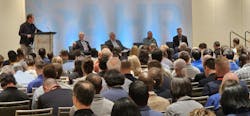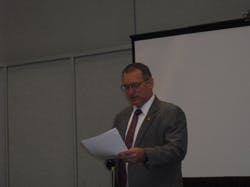2014 AHR Expo: BEQ Certifications, International Memberships on ASHRAE President’s Agenda
ASHRAE is looking ahead to find ways to adapt to a growing international membership and to enhance adoption of its Building Energy Quotient (bEQ) label, but there are some areas—such as indoor-air quality (IAQ)—on which it needs to refocus, ASHRAE President William P. Bahnfleth, PhD, PE, FASHRAE, FASME, said.
Bahnfleth, a member of HPAC Engineering’s Editorial Advisory Board, was speaking at the ASHRAE Press Breakfast at the 2014 Air-Conditioning, Heating, Refrigerating Exposition (AHR Expo).
ASHRAE continues to work on building performance, particularly through Standard 214P, Standard for Measuring and Expressing Energy Performance in a Rating Program; Standard 189.1 Standard for the Design of High-Performance, Green Buildings Except Low-Rise Residential Buildings; and Standard 90.4P, Energy Standard for Data Centers and Telecommunications Buildings.
“The bEQ label continues to be developed, but we are trying to find ways to get wider adoption of the label,” Bahnfleth said. To that end, the association will allow—at least for the time being—non-ASHRAE professionals to submit applications for BEQ certification.
Bahnfleth added that the bEQ is not in competition with the U.S. Green Building Council’s (USGBC’s) Leadership in Energy and Environmental Design (LEED) program. To the contrary, he said, ASHRAE has a good partnership with the USGBC, and applying ASHRAE standards is an important part of achieving LEED certification.
“USGBC has created public and government awareness of sustainability in a way that some others have not, and we have to thank them for that,” Bahnfleth said.
He added that if bEQ is in “competition” with anything, it is ENERGY STAR, although ENERGY STAR is designed to be low-cost, easy to achieve, and to encourage wide participation, and bEQ is designed to provide a “next step” and includes much greater detail on how to improve a building.
Other highlights:
• IAQ: ASHRAE needs to reemphasize the importance of IAQ. There has never been a concerted effort to develop government awareness of IAQ and create a legislative agenda,” Bahnfleth said.
• Residential buildings: ASHRAE should look to play a more important role in residential buildings. “ASHRAE was never meant to be retrained to commercial buildings,” Bahnfleth said. “We need to examine what capabilities we have to serve the market and what other associations are out there that we could partner with. Partnership will be key in determining our role.”
• Developing markets: ASHRAE must look at developing markets to determine those markets’ needs and how the association could meet those needs.
• International memberships: “New international members are running two- or three-to-one compared to new North American members,” Bahnfleth said. “We need to determine how our organization can best serve a growing international membership.”
Bahnfleth said ad hoc committees have been formed to address these areas during his term as president.










